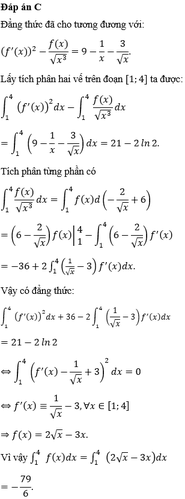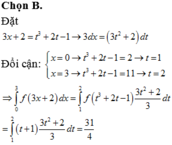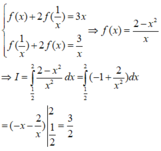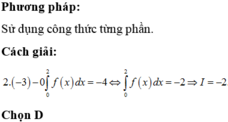Cho hàm số f(x) = x^3 - 3x^2 + 2. 1. Tìm khoảng đồng biến và nghịch biến của hàm số. 2. Tìm các điểm cực đại và cực tiểu của hàm số. 3. Tìm giá trị lớn nhất và giá trị nhỏ nhất của hàm số trên đoạn [-1, 1].
Hãy nhập câu hỏi của bạn vào đây, nếu là tài khoản VIP, bạn sẽ được ưu tiên trả lời.


Chọn C.
Đặt u = G ( x ) d v = f ( x ) d x ⇒ d u = G ( x ) ' d x = g ( x ) d x v = ∫ f ( x ) d x = F ( x )
Suy ra: I = G ( x ) F ( x ) 2 0 - ∫ 0 2 F ( x ) g ( x ) d x
= G(2)F(2) – G(0)F(0) – 3 = 1 – 0 – 3 = -2.

\(f\left(0\right)=-1\Rightarrow f'\left(0\right)+2=0\Leftrightarrow f'\left(0\right)=-2\)
\(\int\limits^1_0f\left(x\right)dx=\int\limits^1_0\dfrac{f'\left(x\right)-x.e^{3x}}{2}dx=\dfrac{1}{2}\int\limits^1_0f'\left(x\right)dx-\dfrac{1}{2}\int\limits^1_0x.e^{3x}dx=\dfrac{1}{2}f\left(x\right)|^1_0-\dfrac{1}{2}\int\limits^1_0xe^{3x}dx\)
\(I_1=\int xe^{3x}dx\)
\(\left\{{}\begin{matrix}u=x\\dv=e^{3x}dx\end{matrix}\right.\Rightarrow\left\{{}\begin{matrix}du=dx\\v=\dfrac{1}{3}e^{3x}\end{matrix}\right.\)
\(\Rightarrow I_1=\dfrac{1}{3}xe^{3x}-\dfrac{1}{3}\int e^{3x}dx=\dfrac{1}{3}xe^{3x}-\dfrac{1}{9}e^{3x}\)
\(\Rightarrow I=\dfrac{1}{2}f\left(1\right)-\dfrac{1}{2}f\left(0\right)-\dfrac{1}{2}\left(\dfrac{1}{3}xe^{3x}-\dfrac{1}{9}e^{3x}\right)|^1_0\)
Èo, tắc chỗ f(1) rồi, vậy đành phải biến đổi để tìm f(x) luôn vậy, hmm
Thử nhân 2 vế với \(e^{2x}\) xem nào:
\(e^{2x}f'\left(x\right)-2e^{2x}f\left(x\right)=x.e^{5x}\Leftrightarrow\left(e^{2x}.f\left(x\right)\right)'=x.e^{5x}\)
Lay nguyen ham 2 ve:
\(e^{2x}.f\left(x\right)=\int x.e^{5x}dx\)
\(\left\{{}\begin{matrix}x=u\\dv=e^{5x}dx\end{matrix}\right.\Rightarrow\left\{{}\begin{matrix}dx=du\\v=\dfrac{1}{5}e^{5x}\end{matrix}\right.\)
\(\Rightarrow e^{2x}.f\left(x\right)=\int x.e^{5x}dx=\dfrac{1}{5}x.e^{5x}-\dfrac{1}{5}\int e^{5x}dx=\dfrac{1}{5}xe^{5x}-\dfrac{1}{25}e^{5x}+C\)
\(f\left(0\right)=-1\Leftrightarrow f\left(0\right)=-\dfrac{1}{25}+C=-1\Leftrightarrow C=-\dfrac{24}{25}\)
\(\Rightarrow f\left(x\right)=\dfrac{\dfrac{1}{5}xe^{5x}-\dfrac{1}{25}e^{5x}-\dfrac{24}{25}}{e^{2x}}\)
Vậy là xong rồi \(\Rightarrow f\left(1\right)=...\) , thay vô \(I=\dfrac{1}{2}f\left(1\right)-\dfrac{1}{2}.\left(-1\right)-\dfrac{1}{2}\left(\dfrac{1}{3}xe^{3x}-\dfrac{1}{9}e^{3x}\right)|^1_0\) là được nha :)
Nguyên tắc:
\(g\left(x\right).f'\left(x\right)+h\left(x\right).f\left(x\right)=p\left(x\right)\)
Đầu tiên luôn biến đổi để \(f'\left(x\right)\) đứng riêng biệt 1 mình:
\(\Rightarrow f'\left(x\right)+\dfrac{h\left(x\right)}{g\left(x\right)}.f\left(x\right)=\dfrac{p\left(x\right)}{g\left(x\right)}\) (1)
Cần thêm/bớt, nhân/chia sao cho biến về dạng:
\(\left[u\left(x\right).f\left(x\right)\right]'=q\left(x\right)\)
\(\Leftrightarrow f'\left(x\right).u\left(x\right)+u'\left(x\right).f\left(x\right)=q\left(x\right)\)
\(\Leftrightarrow f'\left(x\right)+\dfrac{u'\left(x\right)}{u\left(x\right)}.f\left(x\right)=\dfrac{q\left(x\right)}{u\left(x\right)}\)
Chỉ quan tâm vế trái, khi đó ta sẽ thấy hàm đằng trước \(f\left(x\right)\) chính là \(\dfrac{u'\left(x\right)}{u\left(x\right)}\)
Đồng nhất \(\Rightarrow\dfrac{u'\left(x\right)}{u\left(x\right)}=-2\)
Lấy nguyên hàm 2 vế \(\Rightarrow ln\left|u\left(x\right)\right|=-2x\Rightarrow u\left(x\right)=e^{-2x}\)
Do đó, ở bài toán ban đầu ta cần nhân 2 vế của (1) với \(u\left(x\right)=e^{-2x}\) nghĩa là:
\(f'\left(x\right)-2f\left(x\right)=x.e^{3x}\Leftrightarrow e^{-2x}.f'\left(x\right)-2e^{-2x}.f\left(x\right)=x.e^x\)
\(\Leftrightarrow\left[e^{-2x}.f\left(x\right)\right]'=x.e^x\)
Nguyên hàm 2 vế: \(\Rightarrow e^{-2x}.f\left(x\right)=\left(x-1\right)e^x+C\)
Thay \(x=0\Rightarrow1.f\left(0\right)=-1+C\Rightarrow C=0\)
\(\Rightarrow e^{-2x}.f\left(x\right)=\left(x-1\right)e^x\Rightarrow f\left(x\right)=\left(x-1\right)e^{3x}\)
\(\Rightarrow I=\int\limits^1_0\left(x-1\right)e^{3x}dx=...\)

Đặt ![]()
![]()
Khi đó



Chọn đáp án C. *Chú ý tính chất tích phân:


Chọn đáp án C.

2: ĐKXĐ: x<>1
\(f'\left(x\right)=\dfrac{\left(x^2-3x+3\right)'\left(x-1\right)-\left(x^2-3x+3\right)\left(x-1\right)'}{\left(x-1\right)^2}\)
\(=\dfrac{\left(2x-3\right)\left(x-1\right)-\left(x^2-3x+3\right)}{\left(x-1\right)^2}\)
\(=\dfrac{2x^2-5x+3-x^2+3x-3}{\left(x-1\right)^2}=\dfrac{x^2-2x}{\left(x-1\right)^2}\)
f'(x)=0
=>x^2-2x=0
=>x(x-2)=0
=>\(\left[{}\begin{matrix}x=0\\x=2\end{matrix}\right.\)
1:
\(f\left(x\right)=\dfrac{1}{3}x^3-2\sqrt{2}\cdot x^2+8x-1\)
=>\(f'\left(x\right)=\dfrac{1}{3}\cdot3x^2-2\sqrt{2}\cdot2x+8=x^2-4\sqrt{2}\cdot x+8=\left(x-2\sqrt{2}\right)^2\)
f'(x)=0
=>\(\left(x-2\sqrt{2}\right)^2=0\)
=>\(x-2\sqrt{2}=0\)
=>\(x=2\sqrt{2}\)



